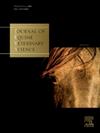Relationships between metabolism of cryopreserved equine sperm determined by the Seahorse Analyzer and sperm characteristics measured by flow cytometry and computer assisted analysis of motility
IF 1.3
3区 农林科学
Q2 VETERINARY SCIENCES
引用次数: 0
Abstract
Metabolic activity of sperm has up to now mainly been determined by measuring mitochondrial membrane potential using flow cytometry, but these assays provide little bioenergetic information about sperm metabolism (Moraes et Meyers et al. Anim Reprod Sci. 2018; 194:71–80). Since a few years oxygen consumption rate (OCR) and extracellular acidification rate (ECAR) of cells can be examined using the Seahorse analyzer (Agilent Technologies, Inc., Santa Clara, CA, United States). Studies with this system have already been performed on sperm of humans (Freitas-Martins et al. 2024; Andrology. 2024 12(2):410-421), mice (Balbach et al. Biol Reprod. 2020 103:791-801) and bovine (Moraes et Anim Reprod Sci. Anim Reprod Sci. 2021; 194:71–80), but to our knowledge not in equine sperm. The aims of our studies were to examine intra- and interindividual variabilities of OCR and ECAR in cryopreserved equine sperm and to investigate relationships of these parameters with sperm characteristics determined by flow cytometric assays and computer assisted sperm analysis. Three cryopreserved ejaculates from each of 21 (n=63) warmblood stallions of the Holsteiner Verband (Elmshorn, Germany) were examined. The quality of the semen samples was characterized using different assays during a period of 120 min by measurements every 15 min at a temperature of 37°C. The sperm metabolism was examined using the Seahorse analyzer by measuring basal OCR and ECAR without manipulation performing the Cell Mito Stress. The total motility (TM) of the sperm was assessed by CASA. Furthermore, a flow cytometric assay was carried out to evaluate simultaneously the percentage of sperm with an intact plasma membrane and negative acrosomal status, sperm with a high esterase activity, high mitochondrial membrane potential, low intracellular Ca2+ level (Bucher et al., J Dairy Sci. 2019; 102(12):11652-11669). The SCSA™ was performed to determine the percentage of sperm with a high DNA fragmentation (%DFI) in each sperm sample. There were high variabilities in OCR (34 ± 28 pmol/min of 1 × 106 sperm) as well as in ECAR (1.89 ± 1.18 mpH/min of 1 × 106 sperm) with high inter- and intraindividual variabilities in OCR- and ECAR values within (CVs: OCR: 22.83 - 93.03; ECAR: 29.46 - 90.16) and between (CVs: 65.33; ECAR: 11.39) stallions. There were no high correlations between OCR- and ECAR values and flow cytometric as well as CASA parameters (r-values: min: -0.44; max 0.55). The results of our study show that there are high intra- and interindividual variabilities in oxygen consumption as well as extracellular acidification. As there were no high correlations between the metabolic parameters and other conventionally determined sperm parameters it can be concluded that the Seahorse Analyzer provides new information about sperm quality.
海马分析仪测定的低温保存马精子代谢与流式细胞术和计算机辅助分析精子运动特性的关系
迄今为止,精子的代谢活性主要是通过流式细胞术测量线粒体膜电位来确定的,但这些检测提供的精子代谢的生物能量信息很少(Moraes et Meyers et al.)。动物生殖科学,2018;194:71 - 80)。近年来,可以使用Seahorse分析仪(Agilent Technologies, Inc., Santa Clara, CA, usa)检测细胞的耗氧率(OCR)和细胞外酸化率(ECAR)。该系统已经在人类精子上进行了研究(Freitas-Martins et al. 2024;雄性科学。2024 12(2):410-421),小鼠(Balbach et al.)。中国畜牧兽医学报(自然科学版),2020(3):791-801。动物生殖科学;2021;(194:71-80),但据我们所知,不是在马的精子中。我们的研究目的是检查冷冻保存的马精子中OCR和ECAR的个体内部和个体间的变异,并研究这些参数与通过流式细胞术和计算机辅助精子分析确定的精子特征之间的关系。研究人员对21匹(n=63)德国荷尔斯泰纳马群(Elmshorn, Germany)的温血种马分别进行了三次冷冻保存的射精检测。在37°C的温度下,每15分钟测量一次,在120分钟的时间内,使用不同的测定方法来表征精液样品的质量。使用海马分析仪测量基础OCR和ECAR来检测精子代谢,无需操作细胞水户应激。CASA法测定精子总活力(TM)。此外,采用流式细胞术同时评估原质膜和顶体阴性状态、高酯酶活性、高线粒体膜电位、低细胞内Ca2+水平精子的百分比(Bucher等人,J Dairy Sci. 2019;102(12): 11652 - 11669)。采用SCSA™测定每个精子样本中具有高DNA片段的精子百分比(%DFI)。OCR(1 × 106个精子34±28 pmol/min)和ECAR(1 × 106个精子1.89±1.18 mpH/min)具有较高的个体间和个体内差异(cv: OCR: 22.83 ~ 93.03;ECAR: 29.46 - 90.16)之间(CVs: 65.33;ECAR: 11.39)种马。OCR-和ECAR值与流式细胞术和CASA参数之间无高度相关性(r值:min: -0.44;马克斯0.55)。我们的研究结果表明,在氧气消耗和细胞外酸化方面存在很高的个体内部和个体之间的差异。由于代谢参数与其他常规测定的精子参数之间没有很高的相关性,因此可以得出结论,海马分析仪提供了关于精子质量的新信息。
本文章由计算机程序翻译,如有差异,请以英文原文为准。
求助全文
约1分钟内获得全文
求助全文
来源期刊

Journal of Equine Veterinary Science
农林科学-兽医学
CiteScore
2.70
自引率
7.70%
发文量
249
审稿时长
77 days
期刊介绍:
Journal of Equine Veterinary Science (JEVS) is an international publication designed for the practicing equine veterinarian, equine researcher, and other equine health care specialist. Published monthly, each issue of JEVS includes original research, reviews, case reports, short communications, and clinical techniques from leaders in the equine veterinary field, covering such topics as laminitis, reproduction, infectious disease, parasitology, behavior, podology, internal medicine, surgery and nutrition.
 求助内容:
求助内容: 应助结果提醒方式:
应助结果提醒方式:


